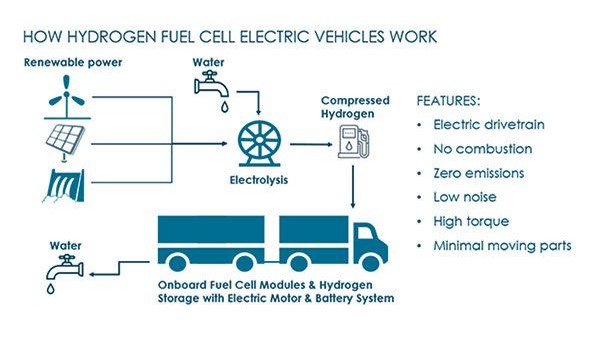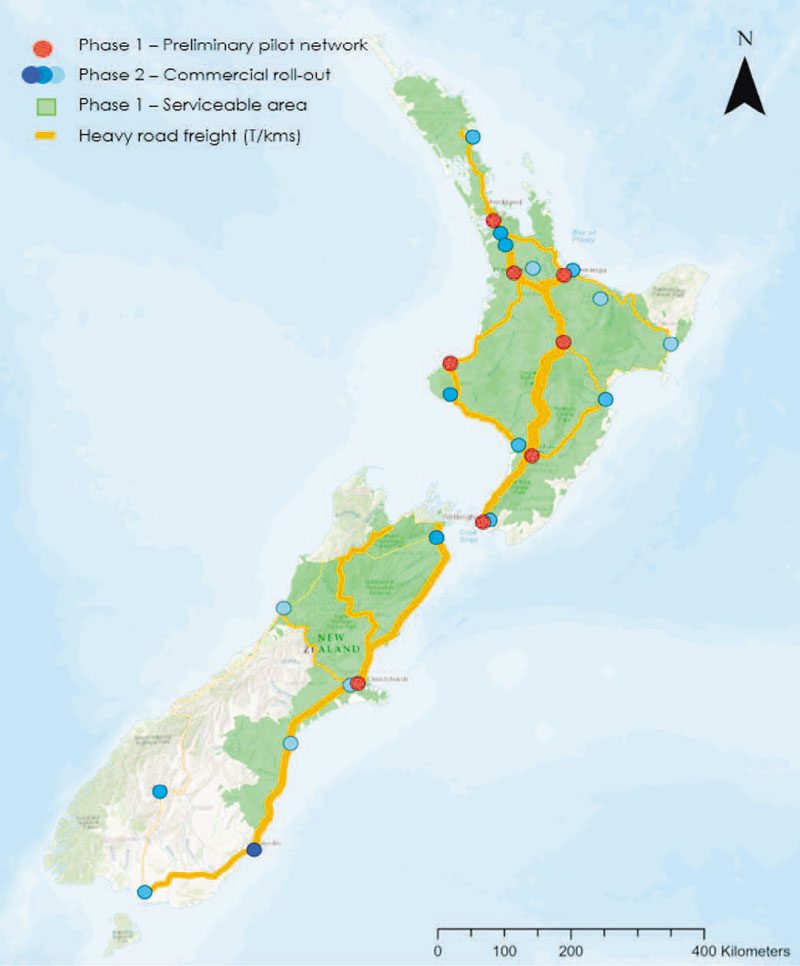NEW ZEALAND’S FUTURE FLEET

What will trucking in a future New Zealand look like? The second of a three-part series by Hiringa Energy.
The future of transportation will be a combination of multiple technologies working in synergy. Battery electric (BEV), hydrogen fuel-cell electric (FCEV), and biofuel vehicles will each have an important role to play and need to be deployed where they work best.
For battery electric, it’s the metro and return-to- base tasks, where the vehicle weight, range and charge times aren’t going to encumber productivity and the electrical grid has capacity.
For hydrogen, it’s linehaul and HPMV operations, where uptime and payload are critical and where fleets are large (with high energy requirements).
For biofuels, it’s the existing legacy fleet of trucks, those that are being road-registered today and will still be on the road (albeit in a reduced capacity) in 2040.
Vehicle owners must be able to choose the option that best suits their needs. It’s too risky for New Zealand to rely on one technology, given the scale of the new fleet required and its variety of uses.
 Mercedes-Benz GenH2.
Mercedes-Benz GenH2.
Committing to hydrogen, providing high impact
Early collaboration with Waitomo Group and some of New Zealand’s largest truck owners and operators, such as TR Group and TIL Freight (now Move Logistics Group), helps to ensure that the hydrogen refuelling infrastructure and vehicles are suitable locally. This combined effort targets the highest impact segments of the freight market, such as line and bulk haul, with one of these trucks emitting as much CO2 as 150 average cars per year.
The carbon reduction impact of addressing this sector of the transport fleet is highly material. For example, the first 300 trucks planned to be introduced by Hiringa and its partners into the heavy- transport fleet will have the equivalent emissions-reduction impact of more than 45,000 cars, at less than one-eighth the capital cost. Hydrogen fuel cells are best suited to electrify these heavy vehicles because of the payload, range, and refuelling advantages over battery-only solutions and deliver the highest emissions impact per vehicle replaced.
As a result of New Zealand’s early investment and planning in hydrogen refuelling infrastructure, industry leaders have secured early access to leading hydrogen FCEV technologies. New Zealand is seen to provide a perfect testbed to establish the commercial rollout of hydrogen-electric heavy- vehicle fleets.
 Hyundai Xcient Fuel Cell.
Hyundai Xcient Fuel Cell.
Hyundai Motors New Zealand, with the support of the Energy Efficiency and Conservation Authority, will bring five zero-emission Xcient hydrogen FCEVs to New Zealand. The trucks are off the production run for Hyundai’s global programme, which will deploy 1600 units into Switzerland by 2025. Hiringa has been working closely with Hyundai New Zealand to ensure its refuelling infrastructure is configured to fuel the vehicles and positioned to serve the target applications within heavy freight for the Xcient platform.
Hiringa has signed a framework agreement with Hyzon Motors to secure production capacity for up to 1500 hydrogen FCEVs for the New Zealand market between 2021 and 2026 as Hiringa builds upon its nationwide refuelling network. An initial tranche of 20 trucks is planned for 2022.
The Hyundai and Hyzon hydrogen FCEVs are designed for regional markets and New Zealand compliance. They will boast ranges of up to 650km with GCMs of between 38 and 58 tonnes and refuel in 10 to 15 minutes. Hydrogen fuel-inclusive leases will be available to freight operators via Hiringa’s partnership with TR Group, lowering upfront capital barriers and ensuring fuel will be available when it’s needed.

Decarbonising legacy fleets
New Zealand has a significant legacy road fleet – some of the oldest average vehicle lives in the OECD – locking in transport emissions for the next 20 to 30 years. There are roughly 150,000 heavy vehicles on New Zealand roads, and the industry brings in about 6000 to 6500 new vehicles per year. Even if we completely stopped procurement of internal combustion engine (ICE) heavy vehicles, it would take more than 25 years to have a zero- emission fleet. According to the Ministry of Transport, there are 255 registered heavy EVs in New Zealand as of June 2021, or roughly 0.2% of the fleet. Our legacy fleet will therefore be an enduring issue.
The introduction of a Sustainable Biofuels Mandate as proposed by the government is necessary to effect change, but we see the role of biofuels is to decarbonise our existing fleet, not to reduce emissions in new vehicles.
It is important to recognise that not all biofuels are created equal and that there are two types of biofuels relevant to trucks – biodiesel and renewable diesel.
Biodiesel (B100), as used across New Zealand today, is manufactured by a chemical process called transesterification. This process combines low-cost waste oils and fats with an alcohol to produce a ‘diesel- like’ replacement fuel. The resulting biodiesel (B100) has different characteristics to conventional diesel and so can cause engine problems, particularly in newer engines. Therefore, B100 biodiesel is blended down to 5% to 20% with regular diesel. The engine-friendly final product is called B5 or B20, depending on the dilution rate.
 Kenworth T680E Battery Electric.
Kenworth T680E Battery Electric.
Renewable diesel (R100) is a biofuel mix of hydrocarbons produced by reacting fats and waste oils with hydrogen at high temperatures. Higher quality than ‘conventional’ B100 biodiesel, R100 renewable diesel can be used as a drop-in fuel and serves as a complete replacement for diesel without the need to blend. According to Neste, the world’s largest producer of renewable diesel, renewable diesel achieves emissions reductions by up to 90% on a lifecycle basis (dependent on feedstock CO2 absorption and processing emissions). Renewable diesel is often referred to as an ‘advanced’ drop-in biofuel.
Targeting electrification will to be key if we are to meet our zero-emission targets for new fleets. A biodiesel blend (B20) will provide some carbon reductions for our legacy truck fleet in the early years. Renewable diesel (R100) is the biofuel that will bring the greatest reduction in emissions, a complete drop-in replacement for diesel.
The high production cost and production scaling limitations of renewable diesel will restrict this technology’s application in new trucks and is one of the reasons the European Union focus has shifted to e-transport (hydrogen and battery electric).
Making low-emission renewable diesel for our legacy fleet is energy-intensive and costly when done in isolation. If renewable diesel is produced in an integrated way with renewable electricity generation and green hydrogen production, its commercialisation is likely to stack up better and attract investment.
However, sourcing enough feedstock to produce either biodiesel or renewable diesel remains a challenge. Scion’s NZ Biofuels Roadmap found that if all current waste and residual biomass feedstock for biofuels were aggregated, we would have enough to substitute about 8.2% of our liquid-fuel demand. According to the 2021 Sapere report, “tallow-based biodiesel (B100) currently sold in New Zealand is imported from Australia and small volumes of biodiesel are produced from domestically sourced used cooking oil”. Currently, the Z biodiesel facility in Wiri can produce 20 million litres of B100 biodiesel per year, about 0.5% of New Zealand’s total diesel usage.
It’s worth the effort to ramp up New Zealand’s R100 renewable diesel capabilities to decarbonise our legacy fleets. But we need to push for decarbonisation from both ends and also start bringing more new zero-emission vehicles into our fleet.
 Hyzon FCEV milk tanker.
Hyzon FCEV milk tanker.
What about converting existing diesel engines?
It is possible to convert or retrofit existing diesel engines to run on hydrogen, supplementing the options for long-life or legacy vehicles. There are two commonly accepted practices. The first is to retrofit the existing diesel intake manifold to blend hydrogen directly into the combustion chamber. The other option is to remove the diesel engine completely and replace it with an electric motor and a fuel cell. Each has its own strengths and weaknesses.
Several commercial companies have developed onboard production, storage, and injection systems for the direct injection of hydrogen into the combustion chamber of a diesel engine. For onboard production, small blends are achievable with some overall fuel savings due to improved combustion efficiency. However, these solutions cannot achieve zero emissions because they rely on the diesel engine itself to produce the hydrogen that’s injected. For systems that have onboard storage, 100% hydrogen blends are possible. However, due to higher flame temperatures, NOx emissions are increased. Typically, direct injection systems run blends of hydrogen to mitigate NOx emissions while also cutting a proportional amount of CO2 emissions due to reduced diesel consumption. While the capital cost of converting to direct hydrogen injection is less than a new fuel cell or battery-powered vehicle today, it does not realise the same efficiency and maintenance gains. A truck running on hydrogen combustion can consume 50% more hydrogen than an equivalent FCEV.
Retrofitting a diesel engine with a fuel cell and electric powertrain is 100% zero- emission when using green hydrogen. This is ideally suited to applications where the vehicle has 15 to 20 years left in the existing chassis and there is sufficient operating life left to recoup the increased cost of repowering it as such. While there are not many companies specialising in these conversions, New Zealand will likely build its own capability in this space. This would likely be seen in marine, rail, and bus applications.
RUC exemption for increased uptake
New BEV and FCEVs are expensive and, to drive material uptake for transition, incentives must support early adopters of zero-emission technology. The Road User Charge (RUC) exemption currently in place for battery electric trucks is a key enabler for the early adoption of these vehicles to undertake light-medium duty tasks. This exemption needs to be extended to cover other low/ zero-emission fuels, such as green hydrogen and R100, which are suited to heavy-duty tasks, so they can effectively compete with diesel in the short term.
The current RUC exemption assumes that trucks are only available in rigid body configuration, providing no recognition that most of the heaviest trucks (the biggest emitters) tow trailers. Also exempting trailers pulled by a zero-emission vehicle would incentivise fleet operators to transition their highest emitting vehicles.
It is important to recognise that using a powerful mechanism, such as the RUC exception, to stimulate uptake of zero-emission heavy-duty vehicles should only be a temporary measure, a way to incentivise the early adopters of the new technologies such that the rest of the industry can benefit from their willingness to innovate. As the uptake of zero-emission trucks rises, and the costs reduce, any government incentives should also diminish.
Dion Cowley is project development and public sector lead at Hiringa Energy.






